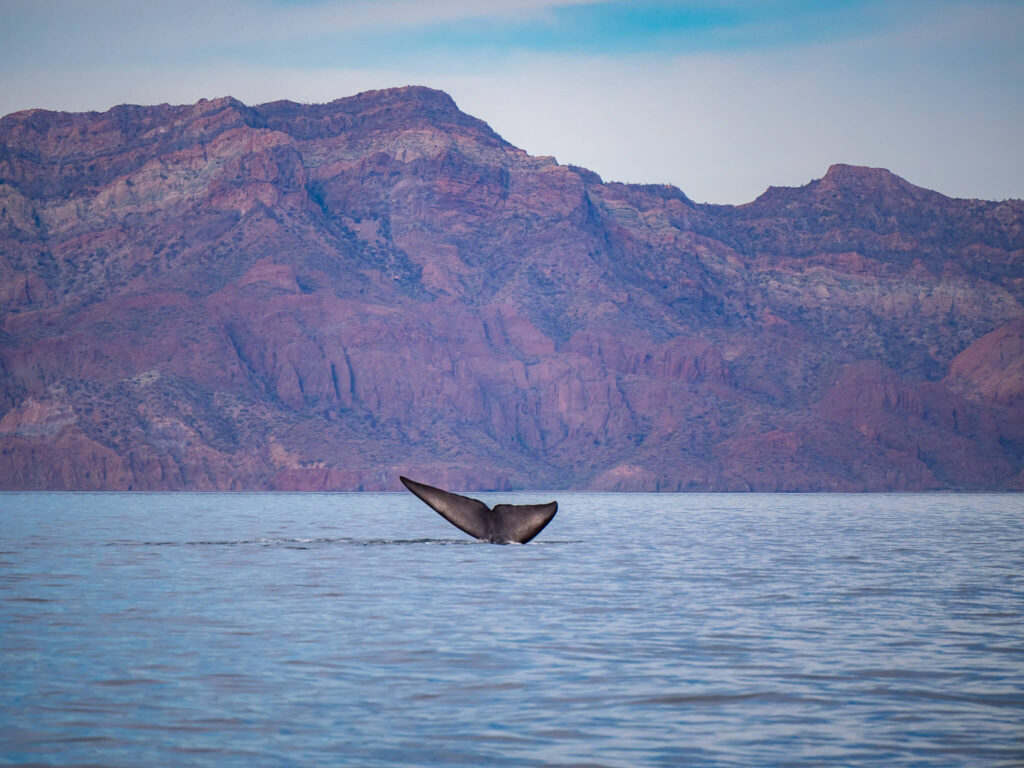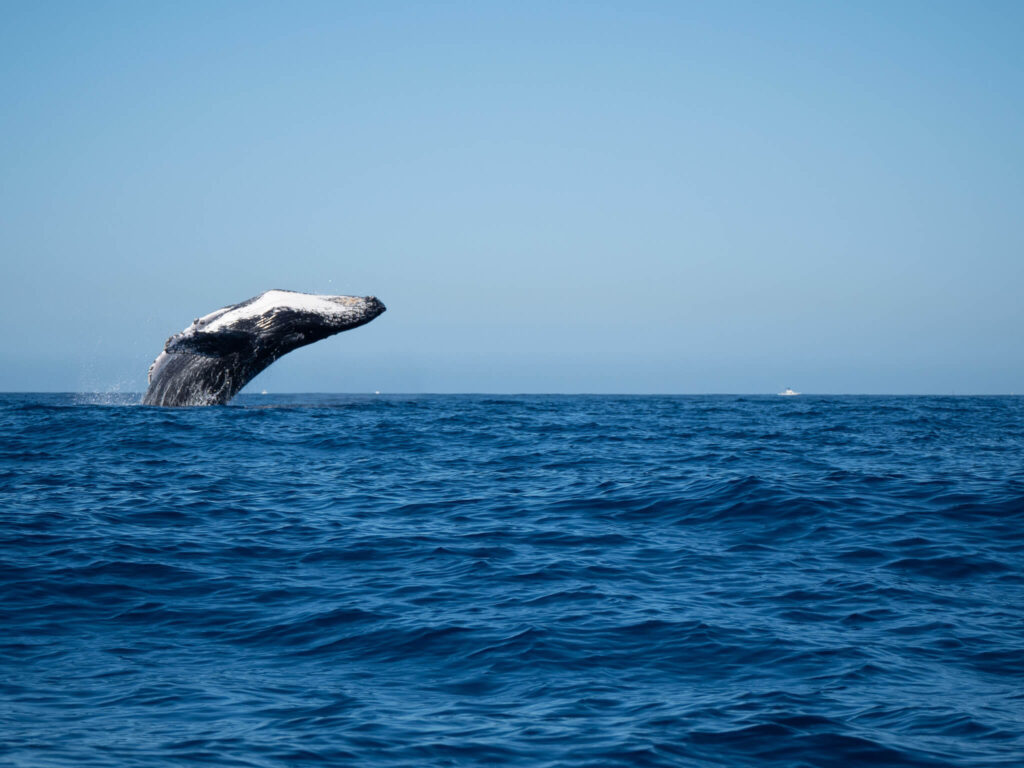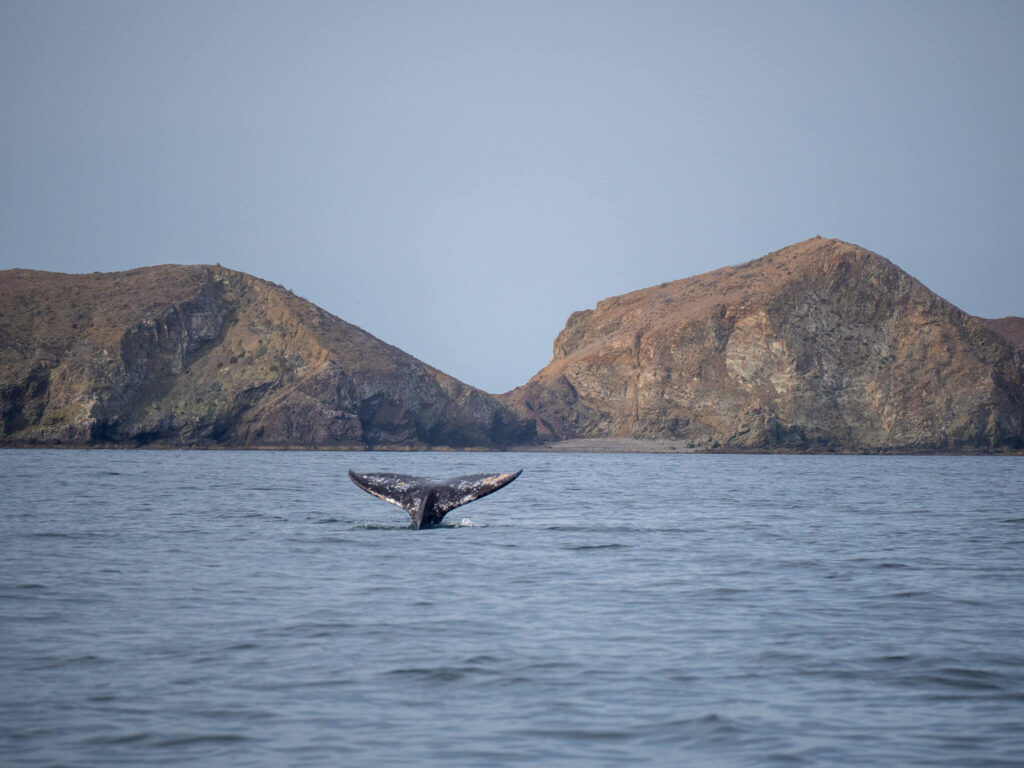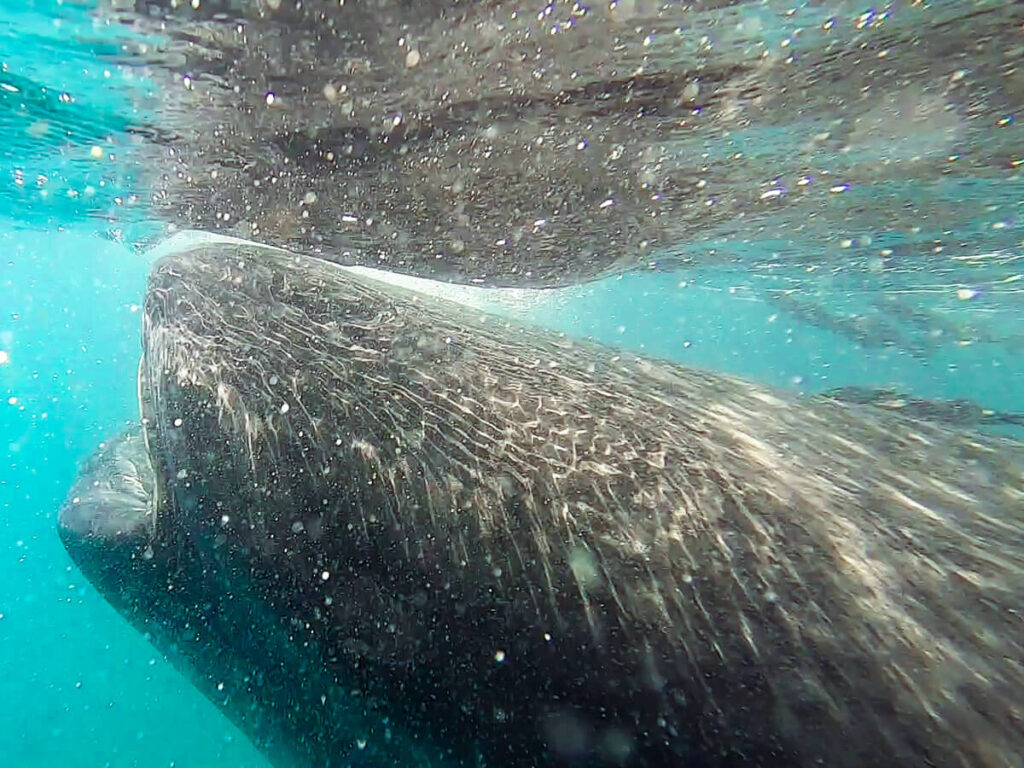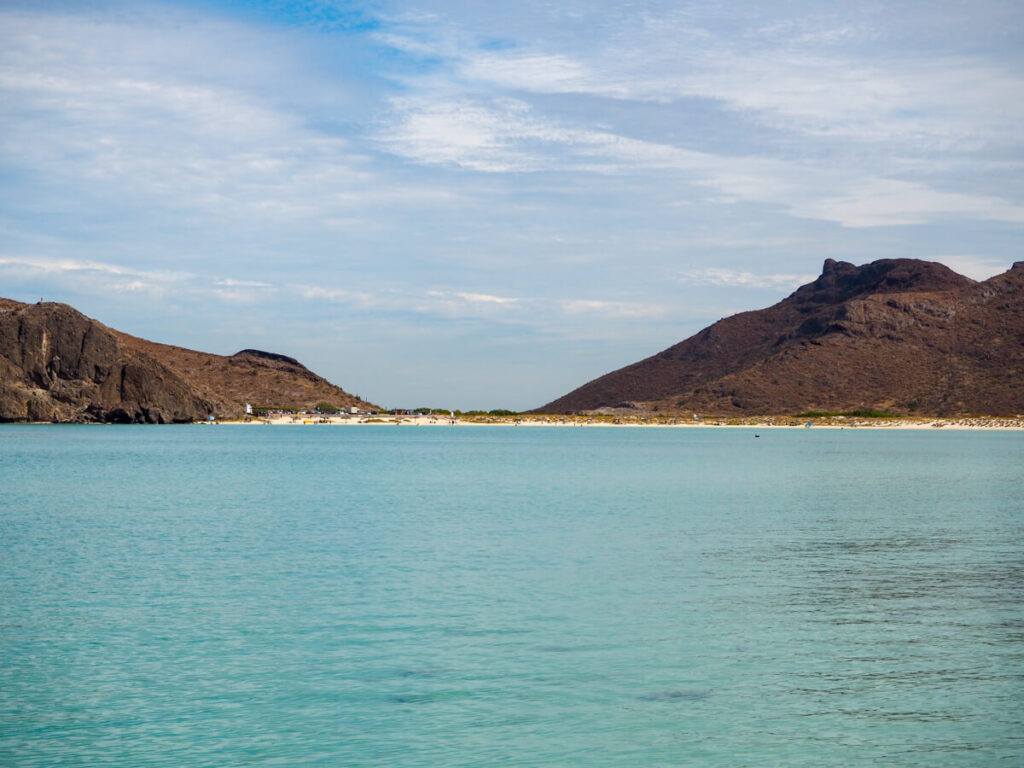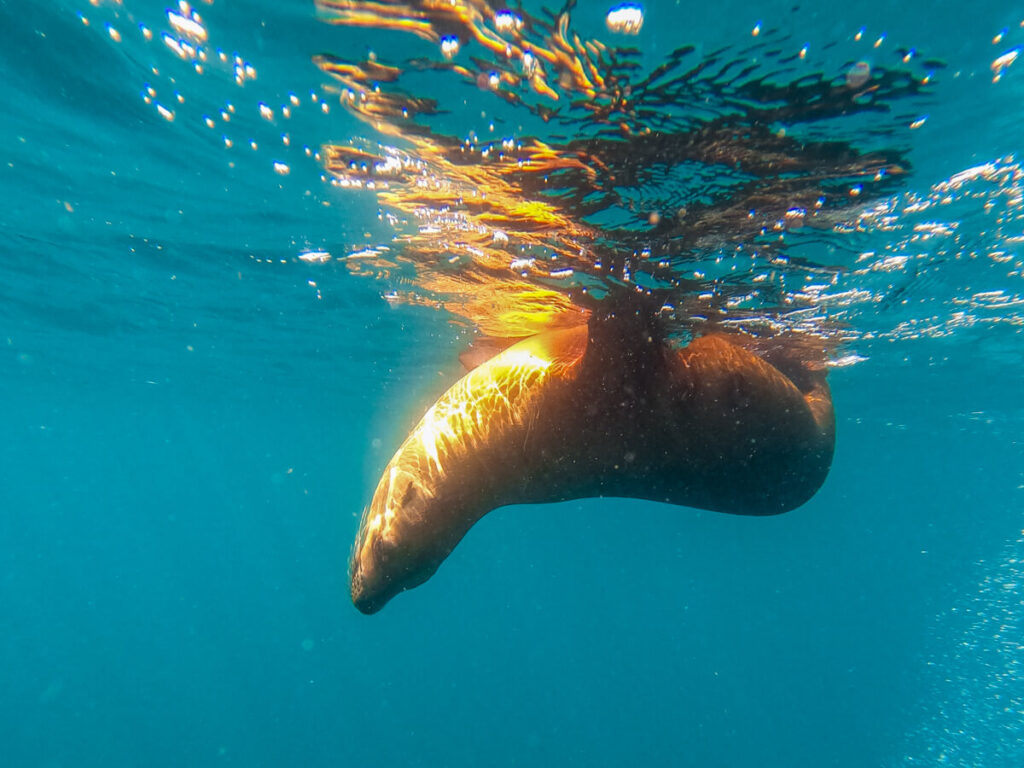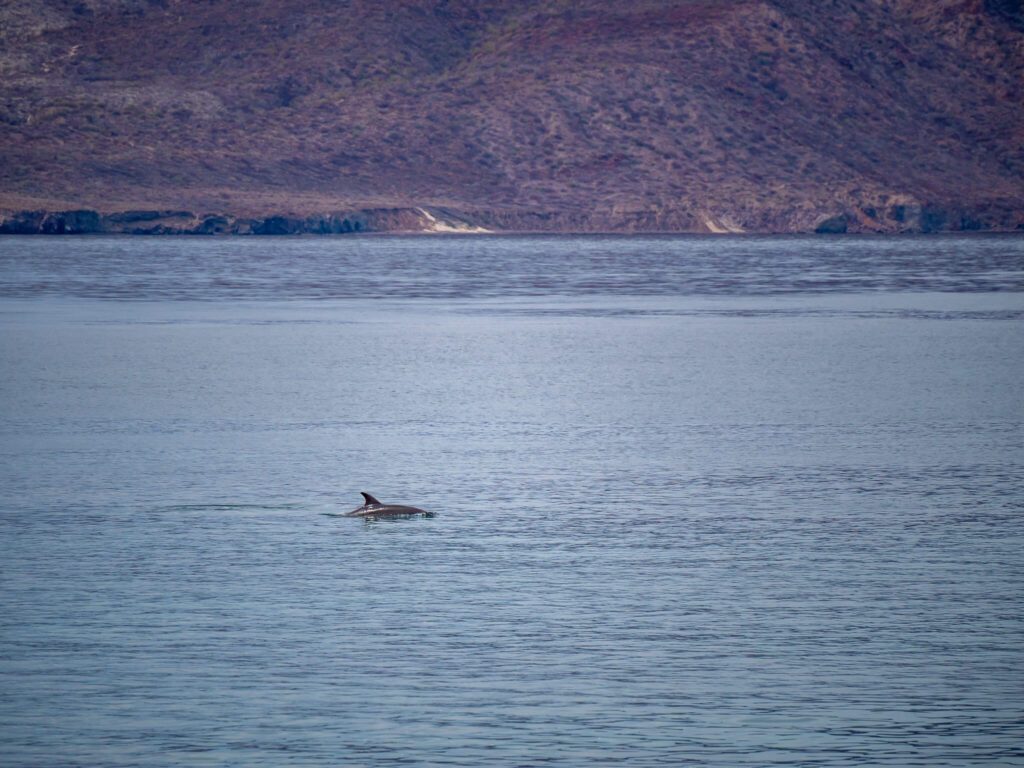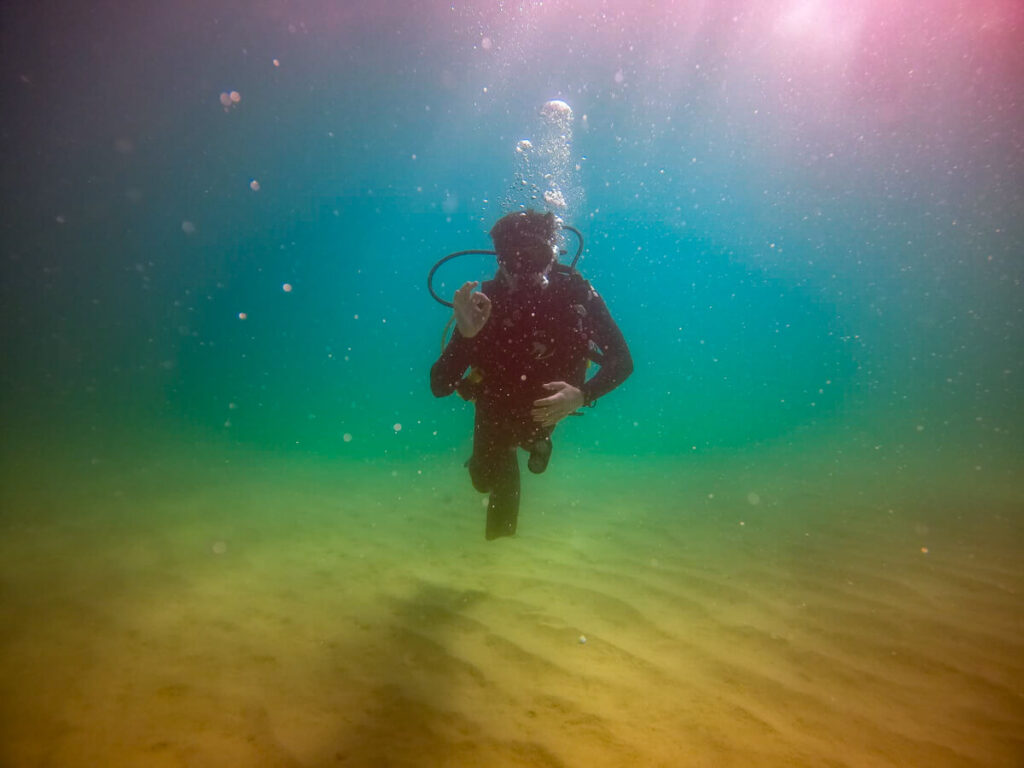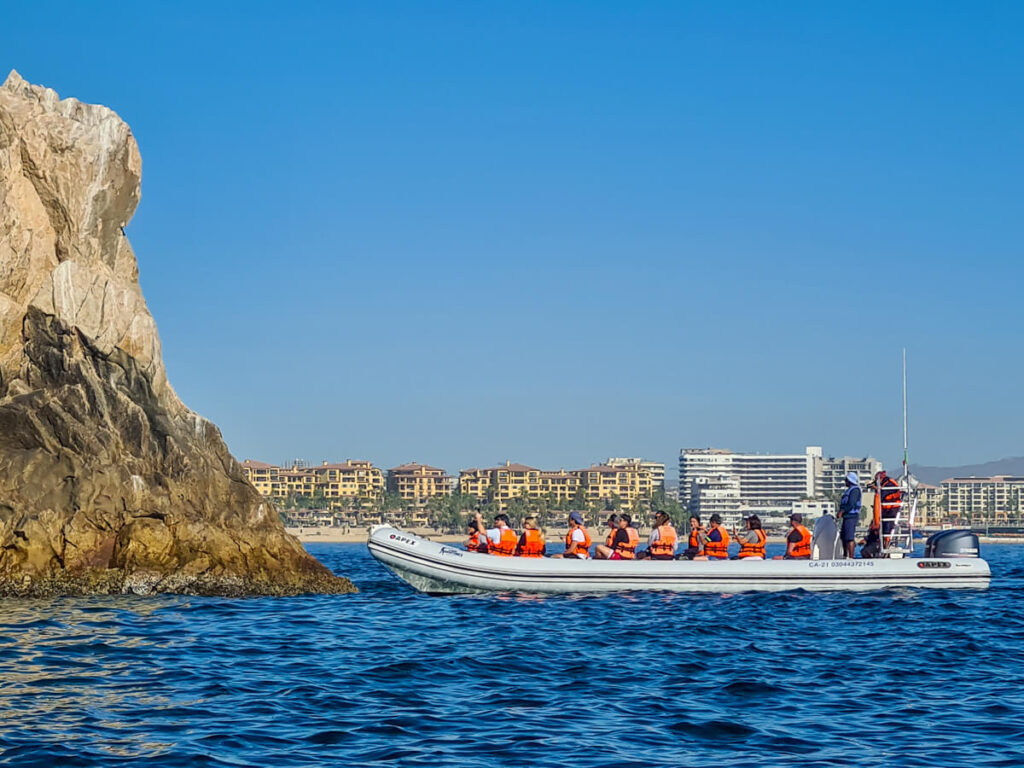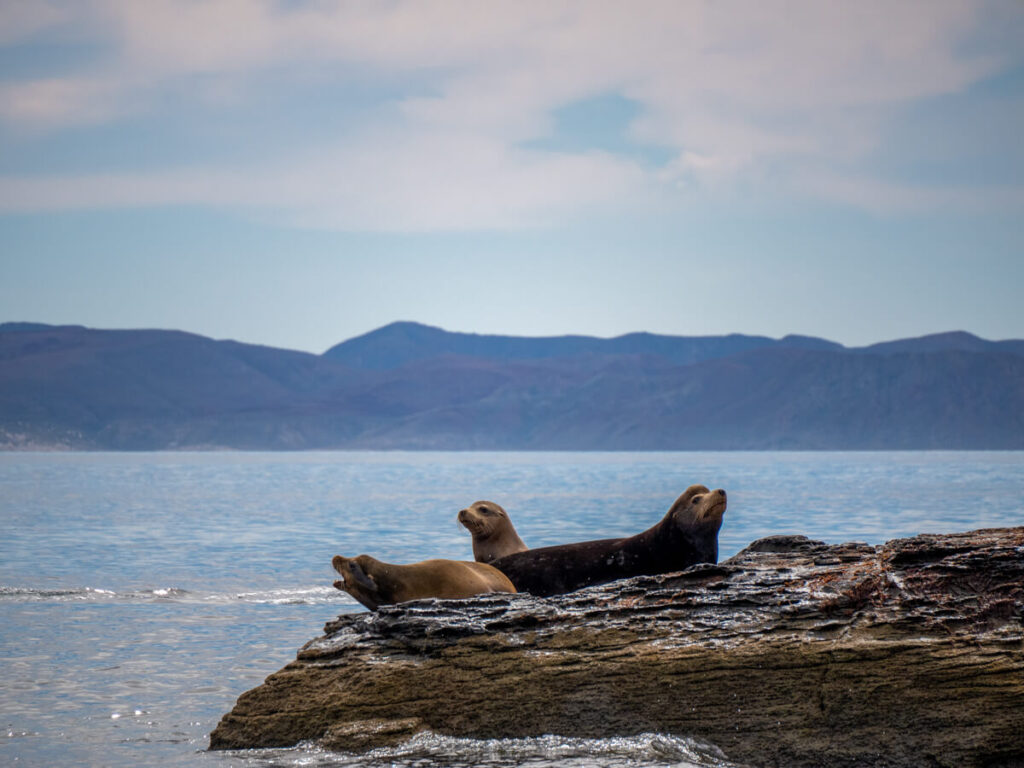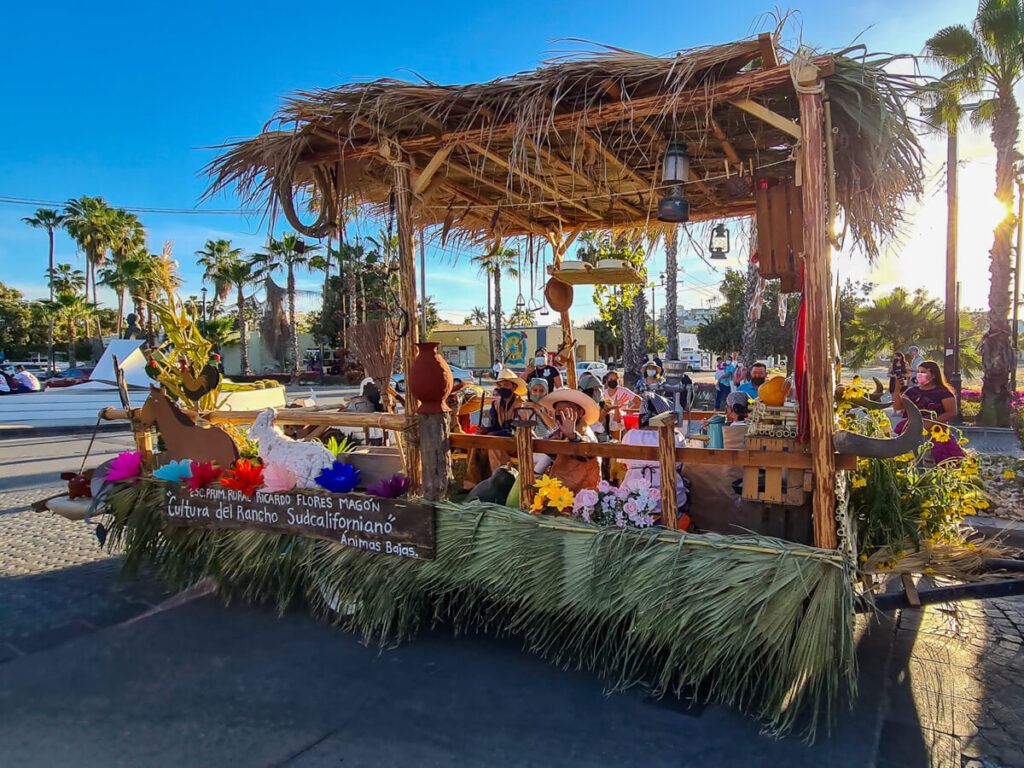A Comprehensive Guide to Travelling Baja California Sur
Is Baja California Sur worth visiting? Everything you need to know about Mexico’s paradisiacal state of Baja California Sur.

This post may contain affiliate links, which means we might earn a small commission on anything purchased through these links at no extra cost to you. Learn more on our disclaimer page.
Welcome to one of our favourite places in the world! Nestled at the southern tip of Mexico’s paradisiacal Baja California peninsula, the state of Baja California Sur is an underrated ecotourism destination. In this travel guide, we’ve included everything you need to know about visiting Baja California Sur, from transportation and accommodation information to the best places to visit and things to do, plus frequently asked questions to make your trip planning a smooth and enjoyable process.
Baja California Sur at a glance

More from La Paz
Where is Baja California Sur?
Baja California Sur lies at the southern tip of the Baja California peninsula off Mexico’s west coast.
Literally translating to ‘Lower California’, the northern state of Baja California sits directly under California, USA and above the state of Baja California Sur.
The southern state of Baja California Sur literally translates to ‘South Lower California’, referring to its location underneath Baja California and California.
Baja California Sur is sandwiched between two ecologically important bodies of water, the Gulf of California (also called the Sea of Cortez) to the east and the Pacific Ocean to the west.

Baja California Sur Map
As you can see from the map below, there’s far more to Baja California Sur than just a couple of cities.

About Baja California Sur
Baja California Sur, often abbreviated to BCS, is one of Mexico’s 32 states. Although it is the ninth-largest Mexican state, Baja California Sur is the least populated state and was the last state to be admitted to Mexico.
Baja means ‘low’ and refers to the part of Mexico that sits below the American state of California. This area takes the form of a 745-mile (1,200-kilometre) peninsula that encompasses two Mexican states. There can be quite a lot of confusion about these two states due to their similar names so we’ve broken down all the terminology below:
The difference between Baja California and Baja California Sur is that they are two separate states that together make up the Baja California peninsula.
Confusingly, the term ‘Baja California’ can sometimes be used to refer to the peninsula rather than the northern state.

Baja California Sur is the only state that is disconnected from the rest of the country as the state of Baja California sits to the north, connecting the peninsula to the Mexican mainland. It is the most popular state for tourism, offering a wealth of activities.
There are also some slang terms for parts of Baja that get used quite frequently which can be quite confusing. We’ve defined them below:

Baja California Sur History
The Baja California Sur state sits on a narrow peninsula that broke away from the Mexican mainland about two million years ago due to tectonic activity.
Carbon dating has proven habitation in Baja California Sur, on Isla Espíritu Santo, dates back to around 40,000 years ago, with evidence of human settlement dating between 10,000 and 21,000 years ago. Baja California Sur is one of five areas in the world with important concentrations of rock and cave paintings, dating to 1700 BCE.
There were four main Indigenous ethnic groups in Baja California Sur:
- Pericúes between Cabo San Lucas and La Paz
- Guaycuras north of the Pericú to Loreto
- Monquis near Loreto
- Cochimí in the middle of the peninsula
Spanish colonisers first arrived in Baja California Sur in the 1500s but, due to its remote nature, Baja California Sur remained largely uncolonised until the 17th century. Jesuit missionaries established churches in the region, starting in Loreto. As more colonists arrived, diseases began to cause a significant decrease in the indigenous populations.
By the 19th century, the missions’ influence dissipated. Baja California Sur was largely untouched by the Mexican War of Independence which freed Mexico from the Spanish Empire. It was later unsuccessfully invaded by the United States during the Mexican–American War and France during the Reform War.
Baja California Sur became a state on 8th October 1974, with three municipalities: La Paz, Comondú and Mulegé. Los Cabos and Loreto were later identified as municipalities too.
Loreto was the original capital of the Baja California peninsula until 1830 when the destruction of the town by heavy rains forced the government’s relocation to La Paz, which has been the capital ever since.

Things to do in Baja California Sur
The region’s unique geology, stunning natural beauty, and vast ocean areas make it the perfect destination for a wide range of activities in Baja California Sur. A popular ecotourism destination, this sun-soaked state is the perfect place for a relaxing vacation, luxurious retreat, adventurous getaway, or budge backpacking journey. Some of the main things to do in Baja California Sur include:
Possibly the most popular attraction to Baja California Sur is its stunning beaches, partnered with a wealth of luxury hotels that make a great base for a holiday.
Of course, with insane marine biodiversity, snorkelling and diving are incredibly popular in Baja California Sur.
Those who wish to enjoy the ocean without getting wet can rent a kayak or paddleboard in the shallows or enjoy a sunset catamaran cruise along the coast.
If you’re after a bit of adrenaline, there are loads of exciting activities on offer from ziplining to jet skiing. A large variety of pelagic species also attracts those who enjoy sport fishing.
It would be remiss of us not to mention whale watching – our favourite travel activity. And whale watching in Baja California Sur is some of the best in the world. With a variety of migratory species appearing around the state at the same time of year, Baja California Sur
Besides whales, the state is also a haven for wildlife and birdwatching, offering travellers amazing animal encounters like swimming with whale sharks in La Paz, witnessing giant schools of mobula rays in Cabo, and snorkelling with sea lions in La Paz.
Baja California Sur is also home to a schedule of vibrant festivals and events, from the Day of the Dead celebration to the traditional San José del Cabo Festival.

What to see in Baja California Sur
Baja California Sur’s natural landscapes are one of the biggest attractions to the state. You might see a wide mix of geological features on one trip, including:
With over 1,000 miles (1600 km) of coastline, Baja California Sur is not only home to some of the most beautiful beaches in Mexico, but some of its sandy shores like Balandra Beach have been voted the best in the world.
The coast here is renowned for its dramatic cliffs and rocky outcrops. The most notable formation is the iconic El Arco sea arch, a popular place for SCUBA diving in Cabo.
The state’s rugged desert terrain is a striking contrast to its coastal beauty. The Sierra de la Laguna mountain range offers epic hiking opportunities through desert valleys dotted with cardon cacti and endemic plant species.
Beyond the beaches and desert, Baja California Sur is also home to a number of picturesque cities with charming old towns that reflect the region’s colonial history.

Top experiences in Baja California Sur
Here are the highlights of a visit to Baja California Sur that we’d highly recommend.
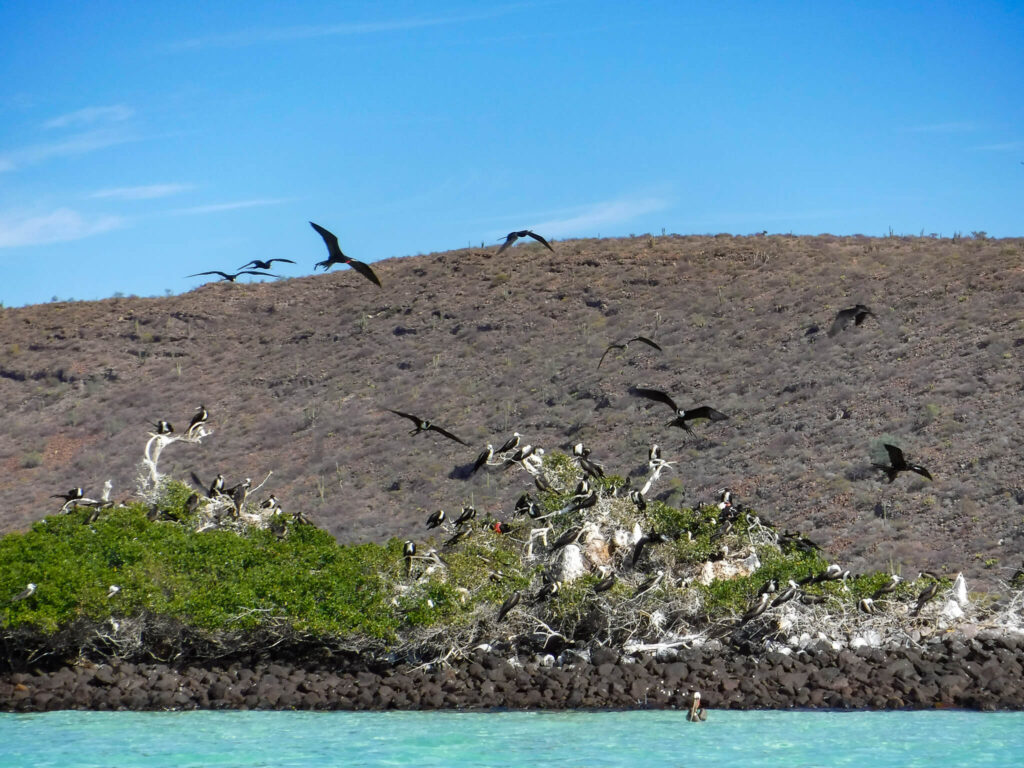 Sailing to Isla Espíritu Santo
Sailing to Isla Espíritu Santo
Where to go in Baja California Sur
If you’re wondering where to go in Baja California Sur, we’ve got you covered. We spent a month travelling the state, seeking the best places in Baja California Sur – and we found them. Each destination showcases a different aspect of Baja California Sur, from busy coastal cities to serene desert towns and unspoiled islands. Here are some of the best places to visit in the state.
Click the images below to read our Baja California Sur destination travel guides.
 Magdalena Bay
Magdalena Bay La Paz
La Paz Loreto
Loreto Cabo San Lucas
Cabo San Lucas San José del Cabo
San José del Cabo Los Cabos
Los Cabos
Baja California Sur Cities
Baja California Sur is home to a handful of cities, each with a different vibe and set of activities on offer.
The state is currently home to three Pueblos Mágicos, small ‘Magical Towns’ where visitors can enjoy rich cultural and historical aspects like art, crafts, cuisine, and natural beauty.
The most notable cities in Baja California Sur are:
We’ve broken down the differences and highlights of each city in the next section.

The best places in Baja California Sur
We’ve covered all the main parts of Baja California Sur in this section, mentioning the main city or town, key attractions, and the best things to do in each area.

1. Los Cabos
Los Cabos is an area that encompasses two main cities: Cabo San Lucas and San José del Cabo.
Cabo San Lucas is the most popular city. It has a huge party vibe and is a popular spring break destination. Luxury resorts favoured by celebrities line the coast and the marina is a popular place to take boat trips in Cabo.
San José del Cabo has a colourful colonial centre, set back from the waterfront. It’s more relaxed and authentic than Cabo San Lucas. The town hosts a famous Art Walk on Thursday evenings, where local galleries open their doors for visitors to explore with canapes and drinks.
Humpback whale watching in Cabo is one of the key draws to the area. Every winter, migratory humpbacks can be seen performing acrobatics off the coastline. They can be spotted from the shore but are best experienced on a boat trip with a licensed and responsible company.

2. East Cape
Baja California Sur’s East Cape (Cabo del Este) is one of the region’s least-travelled areas, but also one of the most beautiful.
Cabo Pulmo National Marine Park is the most popular spot, a UNESCO World Heritage site and a major attraction for divers and snorkelers. It’s one of the most popular day trips from Cabo although you can also stay in the small town.
Los Barriles is a small town known for its laid-back vibe and a hotspot for fishing and water sports, particularly kiteboarding and windsurfing, due to the reliable winds in the area.
La Ribera remains relatively quiet compared to the larger tourist cities and is great for water activities, including kayaking and paddleboarding.
Further inland from Los Barriles and La Ribera, Santiago is the gateway to the striking Sierra de la Laguna mountain range, which offers amazing hikes, a wealth of wildlife, and secluded hot springs.
El Cardonal is a small fishing village that offers an authentic Baja California Sur experience for those who like to get off the beaten path.

3. La Paz
The state capital of Baja California Sur, La Paz is a vibrant city with a relaxed atmosphere. It’s known for its waterfront and Malecón (seaside promenade) which is great for a leisurely stroll or bike ride. Its historic centre is home to colonial-era architecture, vibrant plazas, a historic church, small museums, and outdoor cafes.
The coast around La Paz is home to stunning beaches, including Balandra Beach and La Ventana, as well as stunning hikes that reward visitors with panoramic views of the Sea of Cortez.
La Paz is also the gateway to Isla Espíritu Santo, a pristine island popular for snorkelling, whale watching, and other eco-tourism activities.

4. Loreto
One of the oldest cities in Baja California Sur, Loreto is a peaceful town, perfect for travellers seeking a slower pace and deeper connection with nature and local culture.
The city is the gateway to Loreto Bay National Marine Park, a UNESCO World Heritage site known for its biodiversity and Isla Coronado, a popular day trip destination. This is the best place to enjoy blue whale watching in Loreto in the winter and has been featured in documentaries by National Geographic and the BBC.
To the north of Loreto, Mulege, a Pueblo Mágico, is situated near the Bahía Concepción (Conception Bay), famous for its serene beaches and clear waters.
And if you continue even further you reach the small town of Santa Rosalía, a historic mining town with a distinctive French influence, known for its unique architecture, including the Iglesia de Santa Bárbara, designed by Gustave Eiffel.

5. Pacific Coast
Todos Santos is the main town in the southwest part of the peninsula. Another Pueblo Mágico, Todos Santos is known for its vibrant arts scene and bohemian vibe, as well as being the inspiration behind the song Hotel California by The Eagles.
To the south, Los Cerritos is home to a pristine, wide beach that’s popular for its surf breaks and laid-back atmosphere.
Baja California Sur’s mid-west coast is largely only accessible at Magdalena Bay unit you get to the northern part of the state. A rugged, scenic stretch of coastline, this is the remote and wild side of the peninsula.
Grey whale watching in Magdalena Bay is the main attraction here as friendly whales approach so close to boats in the calving lagoon that you can actually touch them. There are three port towns that access the lagoon: Puerto Adolfo López Mateos, San Carlos, and Puerto Chale. Alternatively, you can stay in a glamping camp on Isla Magdalena and wake up in the bay before a full day of whale watching.

6. El Vizcaíno Biosphere Reserve
Nestled in the northwest corner of Baja California Sur, the protected area of El Vizcaíno Biosphere Reserve (Reserva de la Biosfera El Vizcaíno) is a wildlife-watching paradise.
One of the main attractions to the state is the opportunity to get up close to grey whales in Baja California Sur and El Vizcaíno Biosphere Reserve is home to two of the state’s three grey whale lagoons: San Ignacio and Ojo de Liebre. The nearby town of Guerrero Negro is a great base and a remote, peaceful place with a rich history tied to salt production.

Where to stay in Baja California Sur
The first thing to consider when planning a trip to Baja California Sur is your style of travel. Do you enjoy seeing multiple places in one trip or are you a fly-and-flop traveller who’d rather spend most of your time in the resort? Each part of the state caters to different travel styles and budgets and you might be disappointed if you choose a destination that doesn’t gel with your expectations.
Different places in Baja California Sur make a great base for different activities so it’s important to choose the right area for your interests and preferences. We’ve broken down the main areas tourists visit in Baja California Sur and their highlights below.

Baja California Sur Hotels
After deciding where you’d like to visit in Baja California Sur, it’s time to consider the different types of accommodation. There’s a wide range of hotels in Baja California Sur, from luxury resorts to boutique hotels and budget hostels. We break down all the average prices of budget accommodation in our budget Baja California Sur itinerary.
Hotels in Baja California Sur can range from budget rooms to boutique hotels and luxury resorts. We found Booking.com and Expedia really handy for finding affordable hotels in Baja California Sur as they have filter functions and we could search the map to make sure the location worked for us.
Check out the best hotels in Baja California Sur in our travel guides:
Hotels in Baja California Sur come in all shapes and sizes from all-inclusive resorts to hostels. Boutique hotels, guesthouses, inns, and chain hotels can be found pretty much everywhere. Cabo has the widest range of accommodation as it’s the most touristy area. La Paz and Loreto also offer a good range of hotels.

Baja California Sur All-inclusive Resorts
Most of Baja California Sur’s resorts are hotels that provide packages that include all your meals in on-site restaurants. They can also sometimes include your transportation and activities.
All-inclusive resorts in Baja California Sur are a popular option with fans of the fly-and-flop vacation but come at the disadvantage that you don’t really get to experience the local culture. With stunning natural landscapes, charming historical sites, and world-class local cuisine, it would be a shame to come to Baja California Sur and spend the whole time in the resort.
Most resorts of this type are concentrated in the Cabo area but some can also be found in La Paz, Todos Santos, and Loreto.

Baja California Sur Hostels
Hostels in Baja California Sur are a great way to save money and are most commonly found in Los Cabos and La Paz. You can book a dorm bed in a shared room, or a private room for a little extra, for a fraction of the price of a hotel room, while meeting other like-minded travellers.
Baja California Sur Airbnbs
Self-catering properties are great options for those on a budget or who like to cook for themselves on their holiday. These types of properties usually include basic facilities like a fridge and kettle, as well as a private room and bathroom.
Airbnb was our most used form of accommodation in Baja California Sur. We opted for private apartments with a kitchenette or a private room in a shared house with a kitchen so we could save some money by cooking for ourselves. We also became obsessed with local Mexican food and ate out a lot so this style really worked for us.

Camping in Baja California Sur
We love camping – it’s a great option for people who really want to immerse in the natural beauty of a destination and it’s budget-friendly.
It’s common for travellers from the USA and Canada to drive their own campervan down the peninsula but you can also hire one on arrival or simply bring or buy a tent. iOverlander is a great app for finding camping grounds in Baja California Sur with a variety of sites on offer, from beach campsites to dedicated sites with facilities.
Alternatively, if you like a bit of home comforts when camping, there are quite a few glamping sites around the state in unspoiled, remote destinations, from Isla Espíritu Santo to Magdalena Bay Whales Camp. These camp experiences usually include other activities like kayaking or whale watching, as well as your food and transportation.

What to eat in Baja California Sur
From beachside bars to upscale restaurants, Baja California Sur is home to a diverse culinary scene with options to suit every taste and preference. We had some of the best Mexican food of our lives in Baja California Sur and it’s not hard to find authentic cuisine if you know what you’re looking for.
Check out the best places to eat in Baja California Sur in our food guides:

What food is Baja California Sur known for?
Traditional food in Baja California Sur reflects its coastal geography, rich cultural heritage, and access to fresh, local ingredients, centring around seafood, local meats, and seasonal produce. Some popular local Baja California Sur specialities include:
Baja California Sur is also home to a rich international culinary scene, with Michelin-star restaurants and upscale restaurants serving flavours from around the globe. There’s also a unique culinary movement called ‘Baja Med’ which blends Mexican flavours with Mediterranean and Asian influences.
Many meals are naturally vegetarian or vegan-friendly as they make use of ingredients like tortillas, beans, rice, avocados, and salsa.

How to get to Baja California Sur
Baja California Sur is easily accessible by air, land, and sea.
By plane
Most visitors to Baja California Sur arrive by aeroplane. This is the most convenient way to enter the state and there are a handful of destinations to choose to fly into.
Baja California Sur Airports
There are three main airports in Baja California Sur:
Los Cabos International Airport (Aeropuerto Internacional de Los Cabos) is the most popular airport with tourists, located about 6 miles (10 km) north of San José del Cabo and 25 miles (40 km) northeast of Cabo San Lucas.
La Paz International Airport (Aeropuerto Internacional Manuel Márquez de León) is also widely used internationally, sitting just outside La Paz.
Loreto International Airport (Aeropuerto Internacional de Loreto) is smaller and largely only used internationally by flights coming into Loreto from the USA.
A handful of smaller, more regional airports can be useful for domestic transfers throughout the state too, including Santa Rosalía, Ciudad Constitución, and Puerto Adolfo López Mateos.
Driving time between Los Cabos and La Paz airports is only 2.5 hours, while Loreto is 4 hours from La Paz airport and 6 hours from Los Cabos airport. This makes it easy to fly in and out of different airports if you’d like to see more of the state. We flew into La Paz and out of Los Cabos.

Baja California Sur Flights
Many major cities in the US and Mexico fly directly to Baja California Sur, including American Airlines, Delta, United, Alaska Airlines, WestJet, and Aeromexico.
If you’re coming from further afield, the most common connecting airports are Los Angeles (LAX), San Francisco (SFO), Dallas (DFW), Houston (IAH), Chicago (ORD), New York (JFK), and Miami (MIA).
Cancún (CUN) and Mexico City (MEX) are popular connecting airports in Mexico.

By bus
It’s possible to get to Baja California Sur by bus both from the Mexican mainland and from the USA.
From the USA, you can catch service south from Tijuana with Tufesa, Autotransportes Águila, or Omnibus de México. The journey takes around 15-20 hours so you might want to split it up over multiple days, stopping in Ensenada or Guerrero Negro.
From Mexico, you can take a service from Culiacán or Mazatlán with Tufesa or Autotransportes Águila. This route takes about around 10-12 hours
There are four main bus stations in Baja California Sur that are best to arrive at:
Bus tickets can be purchased in advance either online or directly at bus terminals. It’s worth noting that most of the time you need to pick up a physical ticket from the ticket office, even if you have a digital ticket online.
It’s also recommended to book ahead of time, especially during busy travel seasons like holidays. Many of the most popular routes can be found on Busbud, which is great for checking schedules and route availability.

By car
It’s easy to rent a car in Mexico and driving to Baja California Sur is a popular route for autonomous travellers. Cars can be rented from all three major airports, as well as from many cities and towns around the state. Many Americans drive their own cars or campervans over the border and down the peninsula too.
By boat
It’s possible to take a ferry to Baja California Sur from the Mexican mainland. There are two companies that serve this route landing in La Paz, one departing from Topolobampo and one from Mazatlan. The crossing takes approximately 14 hours.
Some tourists choose to visit Baja California Sur by cruise, which offers a mix of relaxation, adventure, and cultural experiences. These are most popular in the Cabo area with companies including Norwegian Cruise Line and Celebrity Cruises serving the port.

How to get around Baja California Sur
Baja California Sur has around 3511 miles (5,651 km) of highway, 11 ports (five of which are international), and 3 main international airports so it’s super easy to get around. A few of the most popular transportation methods throughout the state include:
On foot
Most cities in Baja California Sur have highly walkable centres or downtown areas, meaning you don’t need transport at all once you’re there. Both La Paz and Loreto have seafront promenades (called a ‘Malecón’) which is a lovely scenic stroll along the waterfront. Cabo San Lucas has a compact marina area while San José del Cabo’s historic centre is quite pedestrianised with cobbled streets and communal plazas.

By bus
Taking the bus when backpacking in Baja California Sur is easy and affordable. We got around on public transportation the entire time we were in the state and didn’t feel limited not having a car. Buses in Baja California Sur are a great way to get between destinations, commute around a city, or transit between the airport, accommodation, and activities.
The two main bus companies in Baja California Sur that run around the state are Aguila and ABC. Both offer comfortable coaches for a decent price.
We took the bus from Loreto to Cabo San Lucas via La Paz and enjoyed a comfortable journey down the peninsula, watching films in Spanish and spotting whales from the road as we went.
There are also serval regional bus companies that operate in specific cities. We took the public Ruta del Desierto bus between Cabo San Lucas and San José del Cabo, and again from there to Los Cabos Airport.
Unlike in other parts of Mexico, colectivos aren’t widely used. However, most of the larger cities and towns have a decent public transport system with regional buses that are affordable.
Bus travel times can be long due to the remote locations along the Baja Peninsula. Be prepared for long rides, and consider bringing snacks, water, and entertainment for the journey.

By taxi
Taxi services are widely available in major cities and tourist destinations throughout the region, including in La Paz, Cabo San Lucas, San José del Cabo, Loreto, and Todos Santos.
While taxis are a quick and easy way to get from A to B, they can be incredibly expensive, especially if you’re planning a longer journey. They’re not very practical for transiting between cities but are great for short journeys between the airport, accommodation, and attractions.
Despite contradictory information online, Uber does operate in Cabo and La Paz and is easy to use.
By shuttle
For those who like to be organised and pre-book transportation, shared shuttles and private transfers are a great option. These bookable services work like taxis and can shuttle you between the airport or key destinations.

By tour
If you plan on doing a lot of sightseeing, organising tours with transportation is a great way to get around the state. We arranged our trip to Magdalena Bay to pick up from La Paz and drop off in Loreto, saving us from making the journey ourselves.
Multi-day tours are also a great option for those who don’t want to have to do a lot of organisation. Baja California Sur multi-day tours are often themed by interests like kayaking, surfing, or whale watching.

By car
It’s not necessary to rent a car in Baja California Sur but it can enhance your experience, allowing you to leave the tourist trail.
Renting a car is a great way to have control over your schedule, allowing you to explore further afield. Many remote parts of the peninsula are only accessible by car and you might struggle to reach them otherwise. However, car rentals can be pricey and it’s possible to visit all the most popular places and major cities without a car.
Baja California Sur’s main road is Mexican Federal Highway 1, which runs from the southern tip of the peninsula at Cabo San Lucas to the United States-Mexico border. Mexican Federal Highway 19 is the second most-used road, providing an alternate route between Cabo San Lucas and La Paz. The main roads aren’t always in the best condition but aren’t too difficult to drive.
A 4×4 isn’t necessary for major roads between cities but is recommended if you plan to visit any remote area. Many major roads are dusty and bumpy so a 4×4 can make the journey more comfortable too.

Is Baja California Sur worth visiting?
Yes, Baja California Sur is absolutely worth visiting! With stunning natural landscapes, rich biodiversity, beautiful beaches, delicious food, a variety of resorts and hotels, and thrilling activities, Baja California Sur is one of the most incredible and rewarding parts of Mexico.
Baja California Sur quickly became one of our favourite places we’ve ever travelled to. We kept extending our time in the state and, after spending months exploring the rest of Mexico, it’s still our favourite part of the country and we’re constantly considering going back.

Our experience in Baja California Sur
Baja California Sur was the entire reason we visited Mexico. Having seen incredible interactions with grey whales on BBC and National Geographic documentaries, we researched the filming locations and, upon finding out there were three lagoons in the state where you can get up close to grey whales, we were sold. Discovering that you could also see blue whales and humpback whales in the state, as well as swim with whale sharks and sea lions, all at the same time really sealed the deal.
We started our trip in La Paz, basking on sun-soaked beaches like Balandra, wandering the beautiful Malecón, eating too many fish tacos, and snorkelling in the crystal-clear waters of Isla Espíritu Santo. Swimming with whale sharks was a dream come true but we actually enjoyed the interactions with cheeky sea lions at Los Islotes and San Rafaelito more.
Then, we headed to Magdalena Bay and stayed in a glamping tent on a remote island in the middle of a lagoon used by grey whales for mating and calving. Waking up to dolphins swimming past a stunning sunrise before a long day of whale watching on the water was incredible. We had numerous encounters with whales who would swim up to the boat, rubbing against the underside and blowing water so close to us we could feel it.
From there, we transited to Loreto, enjoying the laid-back atmosphere, relaxing on volcanic islands, and spotting so much wildlife in Loreto Bay National Park, including fin and blue whales, dolphins, sea lions, and blue-footed boobies.
After the long journey south we stayed in Cabo San Lucas, going out whale watching multiple times and enjoying acrobatic humpback displays, seeing baby whales, and witnessing a heat run. We avoided most of the party scene but did find some authentic restaurants and great vegan cafes.
Finally, we stopped in San José del Cabo and were so pleasantly surprised by how much more authentic and charming it was than Cabo San Lucas. Unfortunately, our trip to Cabo Pulmo was called off due to bad weather (we’d recommend leaving flexibility in your itinerary if you’re planning this in winter) but we happened to be there during the San José del Cabo Festival which was so much fun and really topped off our time in Baja California Sur.

Is Baja California Sur safe?
Baja California Sur is generally very safe with little crime. The state is quite a popular tourist area with comes with various protections including an increased police presence and and heightened security measures in major destinations. The cities aren’t that large and the centres are compact, meaning you’re less exposed to the risks typically associated with larger, more crowded urban areas.
Baja California Sur also has a strong community-based approach to safety, where locals are often helpful and protective of visitors. We’ve always found the best safety advice comes from locals and make a point to ask recommendations of dos and don’t from the people we meet as we travel.
Baja California Sur is actually much safer than many parts of the USA and we felt totally safe throughout our time backpacking through the state.
The northern state of Baja California has a more dangerous reputation than the southern state, especially on the border with the USA and in Tijuana. Located on the tip of the peninsula, Baja California Sur is also less touched by gang crime than other states on the mainland.
As with any destination, it’s best to practice usually safety precautions and avoid:
While some resorts treat their water, it’s best to avoid drinking the tap water in Baja California Sur. You can boil it first or use a reusable bottle with a filter to be safe. It’s also common to purchase a 10-20L bottle of drinking water from local shops, which you can return the empty bottle to to get your deposit back.

Is Baja California Sur cheap?
A trip to Baja California Sur can be affordable or expensive depending on where you stay, what activities you do, and how you choose to travel.
In general prices in the state are comparable to the rest of Mexico and cheaper than places like the USA or Europe. It’s easy to travel Baja California Sur on a budget and, if you’ve more money to spend, there are plenty of fun ways to part from your cash too.
Generally, the Cabo area is the most expensive part of the state and much of Los Cabos is tourism-based with higher prices. La Paz, San José del Cabo, and Todos Santos are more authentic with plenty of tourism opportunities ranging from budget-friendly to luxury experiences. Magdalena Bay, El Vizcaíno Biosphere Reserve, and Cabo Pulmo are technically cheap as remote destinations but can be expensive to get to. And Loreto is a mix with limited accommodation driving up prices but its remote location means cheaper activities than Cabo and La Paz.

Sustainability in Baja California Sur
Sustainability is an important issue in Baja California Sur, especially given its pristine natural areas and diverse selection of wildlife. The region’s rapid growth in tourism, urbanisation, and development has only furthered the need to balance environmental conservation and cultural preservation with economic growth.
Baja California Sur is home to 22% of the country’s total coastline at 1385 miles (2230 km) long, as well as most of Mexico’s islands. The state is home to a large variety of protected areas and ecological reserves, conserving a wealth of flora and fauna, including:
Establishing and managing Marine Protected Areas (MPAs) is done by CONANP (the National Commission of Natural Protected Areas), which is part of Mexico’s environment ministry SEMARNAT (Secretariat of Environment and Natural Resources). This goes a long way to conserving fish stocks and keeping natural areas as pristine as they were before human discovery.
Other efforts in the state include the conservation of natural resources, sustainable agricultural practices, a shift towards renewable energy sources, and improved waste management infrastructure.

There are several aspects you can manage to be a responsible visitor to Baja California Sur.

What to pack to visit Baja California Sur
Packing for a trip to Baja California Sur depends on the activities you plan to do and the season you’re visiting but there are some key items that will always come in handy. Here’s a comprehensive packing list to help you prepare for your trip:

Baja California Sur FAQs
We hope we’ve answered your questions about the beautiful Baja California Sur but we’ve left some final FAQs below to ensure your trip is stress-free and enjoyable.
Why visit Baja California Sur?
Baja California Sur rewards visitors with a stunning mix of natural beauty, adventurous outdoor activities, and a relaxed atmosphere. Whether you’re into beaches, water sports, wildlife, ecotourism, or simply want to enjoy a peaceful escape to a luxury resort or charming colonial town, this southern part of the paradisical Baja California peninsula has something for everyone.
What is the difference between Baja California and Baja California Sur?
Though they are both part of the Baja Peninsula in Mexico, Baja California and Baja California Sur are two separate states. Baja California is located in the northern part of the peninsula and Baja California Sur is the southern state. Each state has its own distinct vibe, landscapes, culture, and appeal.
Which is better, Baja California or Baja California Sur?
Baja California (the northern state) is better if you’re looking for a mix of relaxation and adventure closer to the USA, with options for surfing, wine tasting, and cultural experiences. Baja California Sur (the southern state) is better if you want to enjoy calmer beaches, world-class diving and snorkelling, and a more relaxed vibe, perfect for nature lovers, those looking for a luxury getaway, or anyone wanting to explore beautiful, less crowded beaches and islands.
Which side of Baja is best?
Baja California Sur sits at the southern tip of the Baja California peninsula, sandwiched between the Gulf of California (Sea of Cortez) to the east and the Pacific Ocean to the west. The Pacific Coast is known for its rugged terrain, grey whale lagoons, and big waves, making it a haven for surfers and those looking for more remote and adventurous experiences. While the Sea of Cortez is often referred to as the ‘Aquarium of the World’ because of its turquoise waters, diverse marine life, and perfect conditions for snorkelling, diving, and other water activities.

What are the top 3 cities in Baja California Sur?
The top three cities in Baja California Sur are La Paz, the capital, Cabo San Lucas, the main tourist town, and San José del Cabo, the sister city that is also home to the main international airport. However, we’d also add the laid-back town of Loreto and the bohemian Todos Santos to this list too.
How do you get to Baja California Sur?
Getting to Baja California Sur is fairly straightforward with several ways to travel to the state in Mexico depending on your starting point, preferences, and budget. You can fly, drive, take a bus, and there are even ferry routes.
Can I drive my car to Baja California Sur?
Yes, you can drive your car to Baja California Sur from the USA or Canada and from other parts of Mexico.
Can you swim in Baja California Sur?
Yes, you can swim in Baja California Sur – it’s actually one of the top attractions in the region. The state is famous for its beautiful beaches, crystal-clear waters, and unique marine life, making it a fantastic destination for swimming, snorkelling, diving, and other water activities. However, many beaches, especially on the Pacific side of the peninsula, are prone to rough surf or undercurrents that make it too dangerous to swim. It’s best to choose the right beach for your swimming ability, keep an eye on the weather, and check the sea conditions for the safest experience.
What is the safest part of Baja California Sur?
With a strong focus on tourism, which encourages increased safety measures, most of Baja California Sur is very safe. Tourist areas like Cabo San Lucas, San José del Cabo, La Paz, Loreto, and Todos Santos are some of the safest areas in the state.
What is the crime rate in Baja California Sur?
Baja California Sur is considered one of the safest states in Mexico for both locals and tourists, with relatively low crime rates compared to other regions of the country, and even compared to the USA. Like any popular tourist area, there are occasional incidents of petty theft or scams, but violent crime targeting tourists is relatively rare.

What language is spoken in Baja California Sur?
The official and most commonly spoken language in Baja California Sur is Spanish but English is widely spoken in touristy areas and you may even hear Indigenous languages in more remote areas. Today, the Mixteco and Zapoteco Indians are the only significant indigenous languages spoken in Baja California Sur.
What time zone is Baja California Sur?
Baja California Sur is in the Pacific Time Zone: GMT-7 in winter and GMT-6 in summer. This is a different time zone to Baja California (Norte) in summer as the northern state does not observe Daylight Saving Time.
Do you need a passport for Baja Sur?
Yes, if you are travelling to Baja California Sur from outside of Mexico you will need a passport to enter Mexico.
Do you need a visa for Baja Sur?
Depending on your nationality, you may also need a tourist visa or other entry documents. If you’re travelling as a tourist, you’ll need to fill out a Tourist Card (FMM) which is often provided by airlines or can be obtained at the border or at the airport upon arrival in Mexico. The FMM is typically valid for 180 days (6 months).
Does anyone live in Baja California Sur?
Yes, about 800,000 live in the state of Baja California Sur. It is one of the least populated states in the country but has a decent population residing in the capital city, La Paz, as well as in Los Cabos and Loreto. A thriving expat community also exists within the state.
What does Sur mean in Baja California?
‘Sur’ means ‘south’ or ‘lower’. The name ‘Baja California Sur’ means ‘South Lower California’, referring to its location underneath the northern Baja California state and the American state of California.

Read next:
When to Visit Baja California Sur by Month and Interests
A Budget Baja California Sur Backpacking Itinerary
The Ultimate Guide to Whale Watching in Baja California Sur
Our Baja California Sur Destination Guides:
